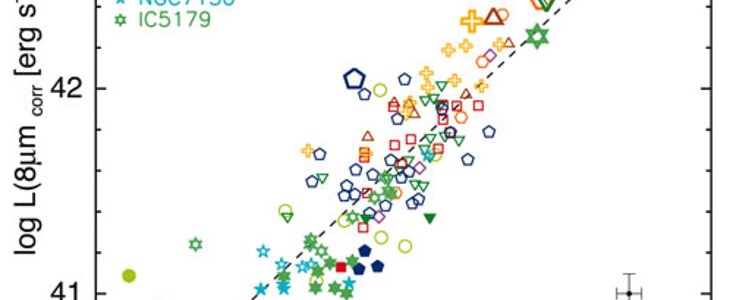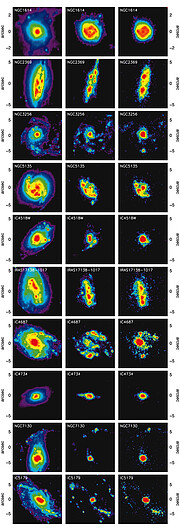Sampling Star-formation in Local LIRGs
6 Mayo 2008
Taking advantage of the spatial resolution and sensitivity offered by T-ReCS on Gemini South, an international team led by Tanio Diaz-Santos (CSIC, Spain) has completed a survey of nearby Luminous Infrared Galaxies (LIRGs) at 8-microns. The survey showed that to first order the star-formation-rate (SFR) of a galaxy can be determined from its 8-micron emission. This is particularly important for these sources since LIRGs produce the majority of their extended IR luminosity in deeply obscured star-forming regions. This makes traditional star-formation rate (SFR) indicators, for example the UV continuum or the H-alpha line emission, unsuitable for use with LIRGs due to the heavy extinction caused by the dust associated with the star formation sites. However, at longer wavelengths the extinction due to the dust begins to decrease and features like the Paschen-alpha line or even the mid-infrared (MIR) dust continuum emission itself serve as reliable tracers of the star-formation rate in these galaxies.
In particular, the study of 8-micron emission in local LIRGs is very interesting since this is the wavelength we are actually observing when we detect 24-micron emission from galaxies located at z~2. This is a very interesting epoch to study since at that time LIRGs produced the bulk of the IR luminosity in the Universe. Since there is now a large amount of Spitzer 24-micron imaging data of LIRGs widely available, by calibrating the 8-micron luminosity of local LIRGs we will be able to determine the SFR of their high-z analogs.
To further the process of calibrating a sample of local LIRGs the team obtained 8-micron imaging of the sample with T-ReCS on Gemini South. The relative proximity of these LIRGs ( < 75 Mpc) and the superior spatial resolution afforded by the Gemini/T-ReCS system allowed the team to probe star-forming regions with an unprecedented spatial resolution of roughly 100 parsec. This level of spatial resolution makes the T-ReCS data quite complementary to near-IR imaging obtained with NICMOS on HST. Indeed, comparison of the T-ReCS data with NICMOS imaging shows a strong correlation between the 8-micron and Paschen-alpha (1.87 micron) morphologies of the local LIRGs in the sample (Figure 1 and 3). Moreover, the team showed that the 8-micron and Paschen-alpha luminosities are also correlated (Figure 2). Since Paschen-alpha measures the total number of ionizing photons in the observed H II regions, this is readily translated into a measure of the star-formation-rate for the observed galaxy.
However, the scatter around the mean trend is non-negligible. The team found that this dispersion is caused by an age effect, in the sense that younger star-forming regions have a lower 8-micron to Paschen-alpha luminosity ratio. An additional issue is that emission from Polycyclic Aromatic Hydrocarbon (PAH) molecules can easily contaminate the 8-micron emission from some of the LIRGs. PAH emission features are commonly (but not always) observed in star-forming regions, but are not necessarily associated with the youngest stellar populations and their intensities could vary from galaxy to galaxy. In summary, the team showed that the 8-micron emission of LIRGs can be used as a SFR indicator to first order, but it depends very much on the local physical conditions of the star-forming regions within each galaxy. Further studies are needed in order to analyze these dependences in detail.<>
Enlaces
- For more details on this work, see the paper recently accepted by the Astrophysical Journal: "Understanding the 8-micron vs. Pa-alpha relationship on subarcsecond scales in Luminous Infrared Galaxies". Also visit the team's webpage.



